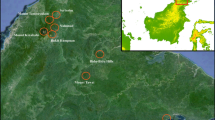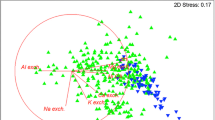Abstract
Serpentine (ultramafic) soils, containing relatively high nickel and other metal concentrations, present a stressful environment for plant growth but also a preferred substrate for some plants which accumulate nickel in their tissues. In the present study we focused on: (1) the relationships between serpentine soils of Lesbos Island (Greece) and serpentinophilic species in order to test their adaptation to the ‘serpentine syndrome’, and (2) the Ni-hyperaccumulation capacity of Alyssum lesbiacum, a serpentine endemic, Ni-hyperaccumulating species, recorded over all its distribution for the first time. We sampled soil and the most abundant plant species from the four serpentine localities of Lesbos Island. Soil and leaf elemental concentrations were measured across all the sites. Our results confirmed our hypothesis that serpentinophilic species are adapted to elevated heavy metal soil concentrations but restricting heavy metal concentration in their leaves. We demonstrated that different A. lesbiacum populations from Lesbos Island present differences in Ni hyperaccumulation according to soil Ni availability. Our results highlighted the understanding of serpentine ecosystems through an extensive field study in an unexplored area. Alyssum lesbiacum and Thlaspi ochroleucum emerge as two strong Ni hyperaccumulators with the former having a high potential for phytoextraction purposes.






Similar content being viewed by others
References
Akeroyd JR (1993) Thlaspi. In: Flora Europaea, vol 1, 2nd edn. Cambridge University Press, Cambridge, pp 384–388
Alexander EB, Coleman RG, Keeler-Wolf T, Harrison SP (2007) Serpentine geoecology of Western North America: geology, soils and vegetation. Oxford University Press, Oxford
Arianoutsou M, Rundel PW, Berry WL (1993) Serpentine endemics as biological indicators of soil elemental concentration. In: Markert B (ed) Plants as biomonitors. VCH, Weinheim, pp 179–189
Ater M, Lefèbvre C, Gruber W, Meerts P (2000) A phytogeochemical survey of the flora of ultramafic and adjacent normal soils in North Morocco. Plant Soil 218:127–135
Baker AJM (1981) Accumulators and excluders—strategies in the response of plants to heavy metals. J Plant Nutr 3:643–654
Baker AJM, Brooks RR (1989) Terrestrial higher plants which hyperaccumulate metallic elements—a review of their distribution, ecology and phytochemistry. Biorecovery 1:81–126
Baker AJM, Reeves RD, Hajar ASM (1994) Heavy metal accumulation and tolerance in British populations of the metallophyte Thlaspi caerulescens J. and C. Presl (Brassicaceae). New Phytologist 127:61-68
Bazos I, Yannitsaros A (2004) Floristic reports from the island of Lesvos (Greece) I. Dicotyledones: Aceraceae to Guttiferae. Edinb J Bot 61:49–86
Brady KU, Kruckeberg AR, Bradshaw HD (2005) Evolutionary ecology of plant adaptation to serpentine soils. Annu Rev Ecol Evol Systemat 36:243–266
Brooks RR (1987) Serpentine and its vegetation: a multidisciplinary approach. Dioscorides, Oregon
Brooks RR (1998) Biogeochemistry and hyperaccumulators. In: Brooks RR (ed) Plants that hyperaccumulate heavy metals. CAB International, Wallingford, pp 95–118
Brooks RR, Radford CC (1978) Nickel accumulation by European species of the genus Alyssum. Proc Royal Soc Lond B 200:217–224
Brooks RR, Yang XH (1984) Elemental levels and relationships in the endemic serpentine flora of the central Dyke, Zimbabwe and their significance as controlling factors for the flora. Taxon 33:392–399
Brooks RR, Morrison RS, Reeves RD, Dudley TR, Akman Y (1979) Hyperaccumulation of nickel by Alyssum Linnaeus (Cruciferae). Proc Royal Soc Lond B 203:387–403
Dimitrakopoulos PG, Schmid B (2004) Biodiversity effects increase linearly with biotope space. Ecol Lett 7:574–583
Freitas H, Mooney H (1996) Effects of water stress and soil texture on the performance of two Bromus hordeaceus ecotypes from sandstone and serpentine soils. Acta Oecol 17:307–317
Freitas H, Prasad MNV, Pratas J (2004) Analysis of serpentinophytes from north-east of Portugal for trace metal accumulation—relevance to the management of mine environment. Chemosphere 54:1625–1642
Gabbrielli R, Pandolfini T (1984) Effect of Mg+2 and Ca+2 on the response to nickel toxicity in a serpentine and nickel accumulating species. Physiol Plant 62:540–544
Garnier E, Cortez J, Billès G, Navas M-L, Roumet C, Debussche M, Laurent G, Blanchard A, Aubry D, Bellmann A, Neill C, Toussaint JP (2004) Plant functional markers capture ecosystem properties during secondary succession. Ecology 85:2630–2637
Ghaderian SM, Mohtadi A, Rahiminejad MR, Baker AJM (2007a) Nickel and other metal uptake and accumulation by species of Alyssum (Brassicaceae) from the ultramafics of Iran. Environ Pollut 145:293–298
Ghaderian SM, Mohtadi A, Rahiminejad R, Reeves RD, Baker AJM (2007b) Hyperaccumulation of nickel by two Alyssum species from the serpentine soils of Iran. Plant Soil 293:91–97
Hedge IC (1965) Thlaspi L. In: Davis PH (ed) Flora of Turkey and the East Aegean Islands, vol 1. Edinburgh University Press, Edinburgh, pp 333–341
Ingle RA, Mugford ST, Rees JD, Campbell MM, Smith JAC (2005) Constitutively high expression of the histidine biosynthetic pathway contributes to nickel tolerance in hyperaccumulator plants. Plant Cell 17:2089–2106
Kazakou E, Dimitrakopoulos PG, Baker AJM, Reeves RD, Troumbis AY (2008) Hypotheses, mechanisms and trade-offs of tolerance and adaptation to serpentine soils: from species to ecosystem level. Biol Rev 83:495–508
Kelepertsis AE, Bibou A (1991) Heavy metal contamination of soils at old mining sites on Thasos Island, Greece. Environ Geochem Health 13:23–28
Krämer U, Cotter-Howells JD, Charnock JM, Baker AJM, Smith JAC (1996) Free histidine as a metal chelator in plants that accumulate nickel. Nature 379:635–638
Krämer U, Grime GW, Smith JAC, Hawes CR, Baker AJM (1997) Micro-PIXE as a technique for studying nickel localization in leaves of the hyperaccumulator plant Alyssum lesbiacum. Nucl Instrum Methods Phys Res 130:346–350
Kruckeberg AR (1984) California serpentines: flora, vegetation, geology, soils and management problems. University of California Press, Berkeley
Küpper H, Lombi E, Zhao F-G, Wieshammer G, McGrath SP (2001) Cellular compartmentation of nickel in the hyperaccumulators Alyssum lesbiacum, Alyssum bertolonii and Thlaspi goesingense. J Exp Bot 52:2291–2300
Lee J, Brooks RR, Reeves RD, Boswell CR, Jaffré T (1977) Plant-soil relationships in a New Caledonian serpentine flora. Plant Soil 46:675–680
Li Y-M, Chaney RL, Brewer EP, Angle JS, Nelkin J (2003) Phytoextraction of nickel and cobalt by hyperaccumulator Alyssum species grown on nickel-contaminated soils. Environ Sci Technol 37:1463–1468
Lombini A, Dinelli E, Ferrari C, Simoni A (1998) Plant-soil relationships in the serpentinite screes of Mt Prinzera (Northern Apennines, Italy). J Geochem Explor 64:19–33
Oze C, Skinner C, Schroth AW, Coleman RG (2008) Growing up green on serpentine soils: biogeochemistry of serpentine vegetation in the Central Coast Range of California. Appl Geochem 23:3391–3403
Pollard AJ, Powell KD, Harper FA, Smith AC (2002) The genetic basis of metal hyperaccumulation in plants. Crit Rev Plant Sci 21:539–566
Prasad MNV, Freitas H (2003) Metal hyperaccumulation in plants—biodiversity prospecting for phytoremediation technology. Electronic Journal of Biotechnology 6 (Available online at: http://ejbiotechnology.ucv.cl/content/vol6/issue3/full/6/index.html)
Proctor J, Woodell SRJ (1975) The ecology of serpentine soils. Adv Ecol Res 9:255–365
Proctor J, Alexeeva-Popova NV, Kravkina IM, Yurtsev BA, Drozdova IV, Kataeva MN (2004) Arctic ultramafics: new investigations on Polar Ural vegetation. In: Boyd RS, Baker AJM, Proctor J (eds) Ultramafic rocks: their soils, vegetation and fauna. Science Reviews, Herts, pp 121–135
Raskin I, Ensley BD (eds) (2000) Phytoremediation of toxic metals: using plants to clean up the environment. Wiley, New York
R Development Core Team (2008) R: a language and environment for statistical computing. R Foundation for Statistical Computing, Vienna, AU. Available at: http://www.R-project.org
Reeves RD (1992) The hyperaccumulation of nickel by serpentine plants. In: Baker AJM, Proctor J, Reeves RD (eds) The vegetation of ultramafic (serpentine) soils. Intercept, Andover, pp 253–277
Reeves RD (2006) Hyperaccumulation of trace elements by plants. In: Morel JL, Echevarria G, Goncharova N (eds) Phytoremediation of metal-contaminated soils. NATO Science Series: IV: earth and environmental sciences, vol 68. Springer, New York, pp 25–52
Reeves RD, Adigüzel N (2008) The nickel hyperaccumulating plants of the serpentines of Turkey and adjacent areas: a review with new data. Turk J Biol 32:143–153
Reeves RD, Baker AJM (1984) Studies on metal uptake by plants from serpentine and non-serpentine populations of Thlaspi goesingense Halácsy (Cruciferae). New Phytol 98:191–204
Reeves RD, Baker AJM (2000) Metal-accumulating plants. In: Raskin I, Ensley BD (eds) Phytoremediation of toxic metals. Wiley, New York, pp 193–229
Reeves RD, Brooks RR (1983) European species of Thlaspi L. (Cruciferae) as indicators of nickel and zinc. J Geochem Explor 18:275–283
Reeves RD, Baker AJM, Kelepertsis A (1997) The distribution and biogeochemistry of some serpentine plants of Greece. In: Jaffré T, Reeves RD, Becquer T (eds) Ecologie des milieux sur roches ultramafiques et sur sols metallifères. ORSTOM, Nouméa, pp 205–207
Reeves RD, Baker AJM, Borhidi A, Berazaín R (1999) Nickel hyperaccumulation in the serpentine flora of Cuba. Ann Bot 83:29–38
Reeves RD, Schwartz C, Morel JL, Edmondson J (2001) Distribution and metal accumulating behaviour of Thlaspi caerulescens and associated metallophytes in France. Int J Phytoremediat 3:145–172
Reeves RD, Baker AJM, Becquer T, Echevarria G, Miranda ZJG (2007) The flora and biogeochemistry of the ultramafic soils of Goiás state, Brazil. Plant Soil 293:107–119
Robinson BH, Brooks RR, Howes AW, Kirkman JH, Gregg PEH (1997) The nickel hyperaccumulator plant Alyssum bertolonii as a potential agent for phytoremediation and phytomining of nickel. J Geochem Explor 59:75–86
Shallari S, Schwartz C, Hasko A, Morel JL (1998) Heavy metals in soils and plants of serpentine and industrial sites of Albania. Sci Total Environ 209:133–142
Shen ZG, Zhao FJ, McGrath SP (1997) Uptake and transport of zinc in the hyperaccumulator Thlaspi caerulescens and the non-hyperaccumulator Thlaspi ochroleucum. Plant Cell Environ 20:898–906
Shewry PR, Peterson PJ (1976) Distribution of chromium and nickel in plants and soil from serpentine and other sites. J Ecol 64:195–212
Smart KE, Kilburn MR, Salter CJ, Smith JAC, Grovenor CRM (2007) NanoSIMS and EPMA analysis of nickel localisation in leaves of the hyperaccumulator plant Alyssum lesbiacum. Int J Mass Spectrom 260:107–114
Strid A, Tan K (2002) Flora Hellenica, vol 2. A.R.G. Gantner Verlag K.G, Ruggell
Wallace AR (1858) On the tendency of varieties to depart indefinitely from the original type. Journal of the Proceedings of the Linnean Society (Zoology) 3:53–62
Walker RB (1954) The ecology of serpentine soils: II. Factors affecting plant growth on serpentine soils. Ecology 35:259–266
Wright JW, Stanton ML, Scherson R (2006) Local adaptation to serpentine and non-serpentine soils in Collinsia sparsiflora. Evol Ecol Res 8:1–21
Acknowledgements
We would like to thank S. Koukoulas for the creation of the GIS-based map depicted in Fig. 1, N. Fyllas for the PCA analysis in the R environment and his comments on the manuscript, and A.Y. Troumbis because he gave us the opportunity to collaborate. This paper forms part of the Innovative Actions 2000–2006—North Aegean 2nd Project (BIOBUS: Biodiversity Resources for Innovative Business Development), EU-DG Regional Policy, decision CCI 2005 GR 16 0 PP 005 [E(2005)5523–13/12/2005].
Author information
Authors and Affiliations
Corresponding author
Additional information
Responsible Editor: Juan Barcelo.
Appendices
Appendix I
Appendix II
Rights and permissions
About this article
Cite this article
Kazakou, E., Adamidis, G.C., Baker, A.J.M. et al. Species adaptation in serpentine soils in Lesbos Island (Greece): metal hyperaccumulation and tolerance. Plant Soil 332, 369–385 (2010). https://doi.org/10.1007/s11104-010-0302-9
Received:
Accepted:
Published:
Issue Date:
DOI: https://doi.org/10.1007/s11104-010-0302-9




